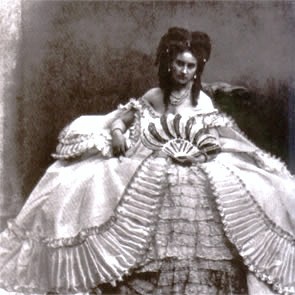|
THE
ITALIAN EXHIBITION-LONDON-1888 A
HISTORIC/MEMORIAL FAN ANNACHECCOLI |
|
|
|
|
|
On may 2nd
1888, London opens the Italian Exhibition of Fine Arts. Many artists will
be among those present, as Carlo Bugatti (1856/1940), architect,decorator,
designer
of furniture and jewels, who will be awarded a price. His furniture are
defined "with copyright"; materials used are wood, bone, ivory
and metal. Eugenio Prati (1842/1907), painter, attended with "Gold
Wedding" and two other paintings. Enrico Melegari (lutist), who was
awarded the gold medal "for the goodness of his violins and the
specialty of his varnishes". The work "Philosophy, history and
literature in the conception of LeoneXIII" planned by the
Saint Giovanni Bosco in 1887 to celebrate the sacerdotal jubilee of
Leone XIII, was awarded the First Honours Certificate of the Italian
Exhibition of London, which take place under the patronage of the English
Royal Family and of Umberto I, King of Italy from 1878 to 1900, with his
consort and cousin Margherita (born in 1851), first Queen of Italy,
daughter
of Ferdinando, Duke of Genoa, and Princess Elisabeth of Saxonia. When she
married the heir to the throne, on April 22nd 1868,she was 17 years old;
so, the Exhibition coincided with their marriage twentieth anniversary.
An other wedding was celebrated at Savoia's House in 1888: that
of Amedeo Ferdinando with his niece Letizia of Savoia-Napoleone. Margherita was a
lover of elegance and jewels. Her motto was: < BEING PRESENT EVERYWHERE
IT'S POSSIBLE TO STRIKE POPULAR FANTASY AND IMAGINATION > The Queen gets
her clothes made by the couturier Charles Frédéric Worth, of
Anglo-Saxon origin, whose official final seal was in France, at the
Napoleon III court. Among his clients, the Princess of Metternich, the
Empress Eugenia, Elisabeth of Austria, the Sicilian Countess Franca
Florio. Luxury lover,
Margherita was of course a great passionately fond of fans too, and
she tried to support anyway the Italian market. The competition created
by the big inflow of Chinese and above all Japanese fans, caused the
closing of several Italian establishments. Mr.Tenenti decided to set up
an his own manufacture, of artistic, luxurious fans, but also of the poor
tradition, with rose wood and bamboo sticks. In 1878, on the
occasion of the visit of Queen Margherita to Milan, he presented her with
a fan of this type, of any intrinsic value, but representative of Italian
industry efforts. Margherita is
also a great supporter of the Burano lace School, where she ordered many
fans. Besides, she lends many exemplars to the first important exhibitions
dedicated to the Fan. In 1908, at the
Society of Fine Arts Exhibition in Florence, there are displaied 440 fans
from Queen's collections and from other important Florentine families. A big
relaunching of the fan matches the relaunching of the lace in Europe in
the last quarter of XIX century. Venetian and Burano lace are the most
refined. Burano school
has been opened a short time before, and it proposes a very large range
of models (sticks from the lowest height of cm.13 to the max of 18. Leaf
from the smallest spread of cm. 30 to the max of cm. 93). In 1879 ten fans
are commissioned, for two Princesses and eight Countesses. Price goes
from 65 to 150 liras. In 1880 Queen Margherita will order three different
models. At the Exhibition of Turin of 1884 price goes from 170 to 105
Liras. At the Paris one, in 1889,price goes from 65 to 100 Liras. In 1900 a Burano
lace fan, with blonde tortoise-shell sticks, guard sticks of gold and
diamonds and Savoia coat of arms costs 840 Liras. But we also know a fan
mounted on 18-carat gold, with diamonds and pearls to the value of 3000
Liras. Queen Margherita died on January 4th 1926 in the Villa Bischoffsheim (then called Etelinda), where she went the first time in 1878, to recover after the attempt on Umberto in Naples. |
|

